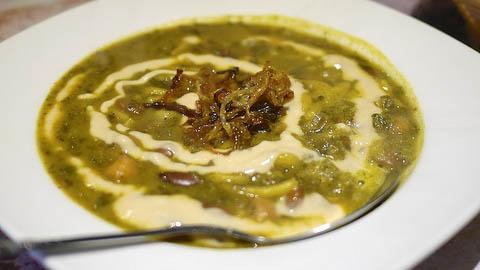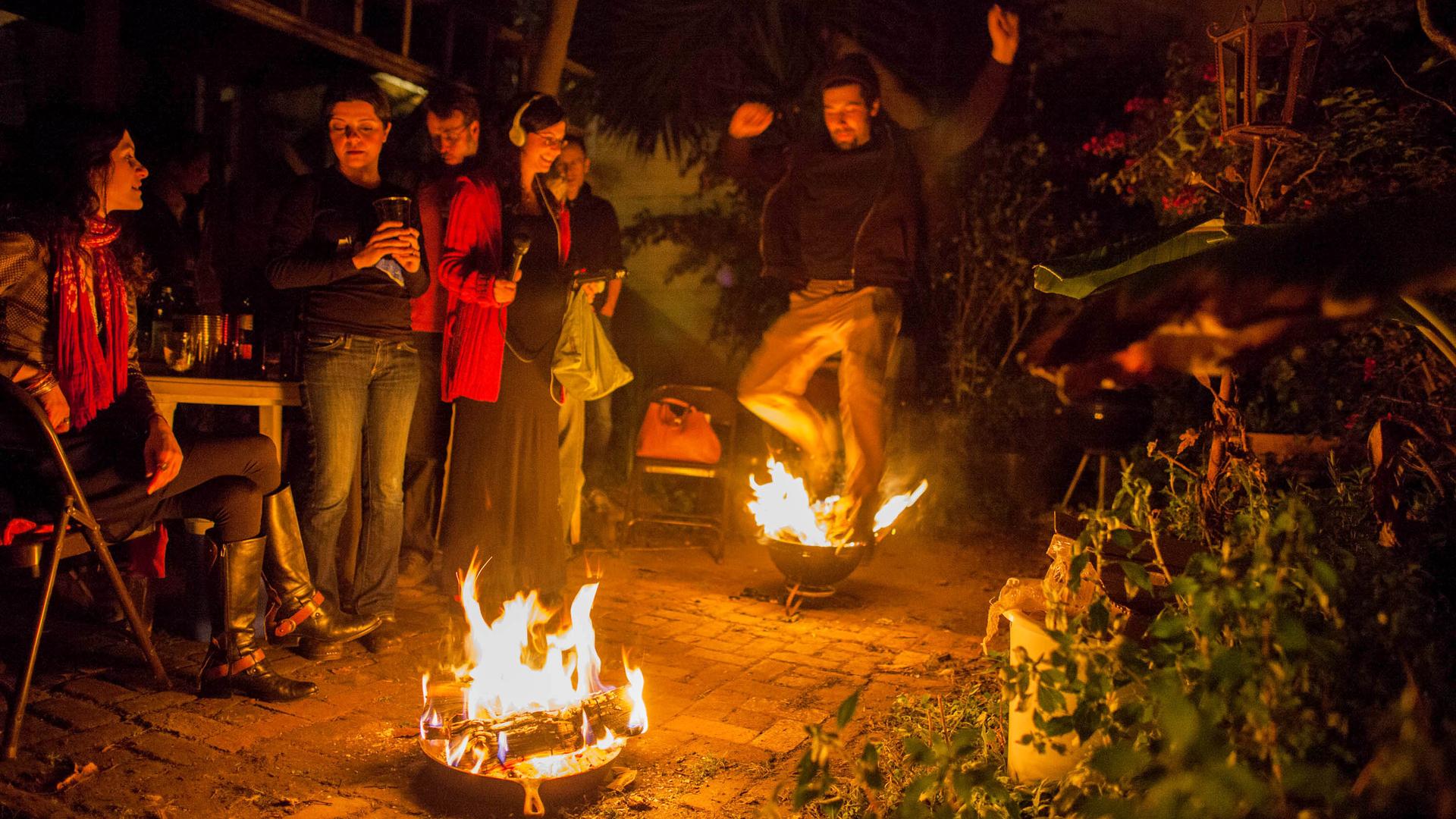Fire-jumping and eating ‘ash’ — let’s ring in the New Year, Persian-style
Reporter Shuka Kalantari records the sounds of a Persian New Year’s celebration at her friend’s home. Jumping over the fire is a symbolic gesture to start a fresh new year.
I'm in a backyard in San Francisco with friends, many of whom are Iranian like me. We're all taking turns jumping over fires burning in large cast-iron pans.
"We're celebrating Chahar Shanbeh Souri — part of the Persian New Year [or Nowruz,]" explains Yasi Mawaz-Khan, the Pakistani Iranian who rallied all our friends to this event. The fire-jumping, she says, is one of the night's rituals.
"I love fire," she adds. "So any reason to make a fire is right up my alley. And I think it's a really good way [to celebrate,] symbolically, the ritual of burning away the bad energy from the last year and making way for the new energy in the new year."
Each time Yasi and anyone else jump over the fire, they shout this phrase:
Zardee maan az toh! Sorkhee toh az maan!
It means "My yellow is yours, your red is mine."
It's a Zoroastrian purification chant. As you hop over the fire, you ask to be rid of any sickness and bad luck — and wish for good luck and health in the new year.
Tara Samiy is the host of the party. She was born in Iran, but raised in the US, and she sees nights like this as holding onto her culture. She also loves that it marks the start of spring.
"Because I think it's so important — the first day of spring and the seeds that you're planting for the year to come. This is part of that, this purification ritual of jumping over the fire. We're asking for the strength of the fire."
Along with fire-jumping, we sing, we dance and we eat. There's always ash, a Persian stew made with beans, spinach, cilantro, parsley, broth and rice or noodles. In Iran, people make cauldrons of it for the New Year and serve it in the streets to the homeless.
Yasi made a big pot for the party. "It's traditional to make ash on Chahar Shanbeh Souri because usually it's really cold on this night," she says, "although tonight is a really nice night. Yeah, and it's a great way to make a one-pot meal for lots of people."
And then someone in the group breaks out the tombak, a Persian drum made with animal hide and wood. But this is only the beginning of Persian New Year parties.
There are two more weeks of eating and singing ahead to celebrate the arrival of spring.

Recipe for Ash Stew, a traditional Persian New Year dish
Credit: Shuka Kalantari and friends (Full disclosure: Shuka and friends were all raised outside of Iran, and they're totally winging this recipe. But it still tastes good.)
- 1/4 to 1/2 cup chickpeas (cooked or soaked overnight)
- 1/4 to 1/2 cup kidney beans (cooked or soaked overnight)
- 1/4 to 1/2 cup dried lentils
- 2 to 3 yellow onion
- 3 to 5 garlic
- 13 to 16 cups vegetable or chicken broth
- 1 bunch chopped parsley
- 1 bunch chopped cilantro
- 1 bunch chopped spinach
- 1 pack of egg noodles, broken up
- Salt
- Turmeric
- Pepper
- Olive oil
- Plain yogurt or whey
Take one onion and thinly slice it and sauté it with olive oil and turmeric till it is caramelized. Set the cooked onion aside.
Then dice the rest of the onion, and sauté with olive oil. Add beans, garlic, turmeric, and a bit more oil. Add stock and bring to a boil. Add salt and pepper to taste. Simmer beans until cooked. (If you used dried chickpeas and kidney beans, cook approximately 1 hour.) Add the noodles and cook until soft. Add parsley, cilantro and spinach a few minutes before noodles are completely cooked. Serve with dollops of yogurt or whey, and garnish with the caramelized onions from earlier.
I'm in a backyard in San Francisco with friends, many of whom are Iranian like me. We're all taking turns jumping over fires burning in large cast-iron pans.
"We're celebrating Chahar Shanbeh Souri — part of the Persian New Year [or Nowruz,]" explains Yasi Mawaz-Khan, the Pakistani Iranian who rallied all our friends to this event. The fire-jumping, she says, is one of the night's rituals.
"I love fire," she adds. "So any reason to make a fire is right up my alley. And I think it's a really good way [to celebrate,] symbolically, the ritual of burning away the bad energy from the last year and making way for the new energy in the new year."
Each time Yasi and anyone else jump over the fire, they shout this phrase:
Zardee maan az toh! Sorkhee toh az maan!
It means "My yellow is yours, your red is mine."
It's a Zoroastrian purification chant. As you hop over the fire, you ask to be rid of any sickness and bad luck — and wish for good luck and health in the new year.
Tara Samiy is the host of the party. She was born in Iran, but raised in the US, and she sees nights like this as holding onto her culture. She also loves that it marks the start of spring.
"Because I think it's so important — the first day of spring and the seeds that you're planting for the year to come. This is part of that, this purification ritual of jumping over the fire. We're asking for the strength of the fire."
Along with fire-jumping, we sing, we dance and we eat. There's always ash, a Persian stew made with beans, spinach, cilantro, parsley, broth and rice or noodles. In Iran, people make cauldrons of it for the New Year and serve it in the streets to the homeless.
Yasi made a big pot for the party. "It's traditional to make ash on Chahar Shanbeh Souri because usually it's really cold on this night," she says, "although tonight is a really nice night. Yeah, and it's a great way to make a one-pot meal for lots of people."
And then someone in the group breaks out the tombak, a Persian drum made with animal hide and wood. But this is only the beginning of Persian New Year parties.
There are two more weeks of eating and singing ahead to celebrate the arrival of spring.

Recipe for Ash Stew, a traditional Persian New Year dish
Credit: Shuka Kalantari and friends (Full disclosure: Shuka and friends were all raised outside of Iran, and they're totally winging this recipe. But it still tastes good.)
- 1/4 to 1/2 cup chickpeas (cooked or soaked overnight)
- 1/4 to 1/2 cup kidney beans (cooked or soaked overnight)
- 1/4 to 1/2 cup dried lentils
- 2 to 3 yellow onion
- 3 to 5 garlic
- 13 to 16 cups vegetable or chicken broth
- 1 bunch chopped parsley
- 1 bunch chopped cilantro
- 1 bunch chopped spinach
- 1 pack of egg noodles, broken up
- Salt
- Turmeric
- Pepper
- Olive oil
- Plain yogurt or whey
Take one onion and thinly slice it and sauté it with olive oil and turmeric till it is caramelized. Set the cooked onion aside.
Then dice the rest of the onion, and sauté with olive oil. Add beans, garlic, turmeric, and a bit more oil. Add stock and bring to a boil. Add salt and pepper to taste. Simmer beans until cooked. (If you used dried chickpeas and kidney beans, cook approximately 1 hour.) Add the noodles and cook until soft. Add parsley, cilantro and spinach a few minutes before noodles are completely cooked. Serve with dollops of yogurt or whey, and garnish with the caramelized onions from earlier.
